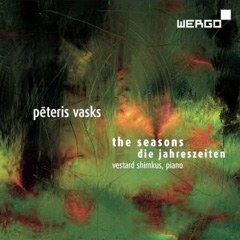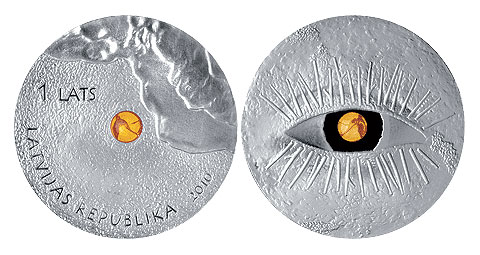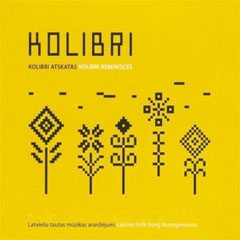
One of the most memorable concerts that I attended in 2009 was the September solo performance of pianist Vestards Šimkus at the Rīga Great Guild. What made this night particularly notable and significant was the fact that Šimkus was performing, for the first time, all four parts of composer Pēteris Vasks’ cycle Gadalaiki (The Seasons).
This was the first time the compositions were performed as a whole, with “Zaļā ainava” (Green Scenery) and “Vasaras vakara mūzika” (Music for a Summer Evening) enjoying their world premiere that night. I wasn’t the only one to be impressed by the concert: The performance was given the “Best Concert Award” as part of the Latvian Great Music Awards.
Due to the historical significance of the evening, it was also recorded for release on compact disc. Produced by the Latvian Concert Agency Latvijas koncerti, the recording of the performance was released in 2010 by the German label Wergo, which has already released a number of Vasks’ works on CD.
Šimkus has already made a worldwide name for himself. In addition to being awarded for performing this cycle, he also received a Latvian Great Music Award in 2002 for his victory at the Franz Liszt competition in Los Angeles, as well as for performances at the Latvian National Opera and at the House of the Blackheads in Rīga.
Vasks, internationally the best-known Latvian composer, was considered to be an “enemy of the state” during Soviet times in Latvia (due to being the son of a Baptist minister and a non-party member) and was forbidden from studying at the Riga Conservatory, though he was able to study in Vilnius, according to the CD booklet.
The first movement to be composed in the Gadalaiki cycle was “Baltā ainava” (White Scenery) in 1980, followed by the second movement, “Rudens mūzika” (Autumn Music), in 1981. Both were composed for his friend Tālivaldis Deksnis, a distinguished Latvian organist.
The third movement, “Pavasara mūzika. Quasi una sonata” (Spring Music), was first performed in Stockholm by pianist Bengt Forsberg in 1996. After hearing Šimkus perform this work in 2004, Vasks was so impressed that he was inspired to compose the final “season” in this cycle, “Zaļā ainava” (Green Scenery). The final piece in this cycle, “Vasaras vakara mūzika” (Music for a Summer Evening) was composed in 2009.
As with much of Vasks’ compositions, the music itself is designed to evoke imagery through sound, rather than focusing on melodies and harmonies. In fact, all of the pieces except “Zaļā ainava” and “Vasaras vakara mūzika” are metrically free—they do not have time signatures, giving them an almost improvisational feel. This could potentially make these piano works difficult to listen to for some, but I think they provide a very rewarding and enjoyable experience to the listener.
“Baltā ainava” begins with quiet melancholy, a peaceful winter scene, a sense of meditation indicating a new beginning of a year—perhaps even a sense of hibernation, of something preparing to wake up.
That awakening comes in “Pavasara mūzika” (a particularly demanding piece that provides a way for Šimkus to display his technical skills), which depicts the arrival of spring, with a thunderous conclusion.
The first section of “Zaļā ainava” is full of constant activity and energy, which then changes to a slower, more subtle view of the season, with Šimkus effortlessly making the very drastic transition between the energetic opening and the nuanced conclusion.
This then leads into “Rudens mūzika,” which also has a very quiet beginning but then grows into a stormy crescendo, concluding with imagery of snow appearing once again, returning the listener to the landscapes of winter.
Finally, there is “Vasaras vakara mūzika,” initially calm, later emotional, but in all an engrossing portrait of a summer evening.
The CD also includes extensive liner notes on the works, as well as in-depth biographies of both Šimkus and Vasks, by Christopher Schlüren (in both German and English).
On a different note, I must also commend the work of the recording engineers, including recording producer and editor Normunds Šnē and recording engineer Andris Ūze, Having attended the concert myself, I recall that there seemed to be a perpetual maelstrom of coughing fits going on throughout the concert, even in very quiet sections. I was quite astonished that none of that thunderous noise has made it into the recording, at least not that I can hear.
Besides being a historically significant release, it is an impressive memento of that memorable evening in September 2009 at the Rīga Great Guild. With the able hands of one of Latvia’s brightest young piano talents, guided by the prowess of the distinguished Vasks, this CD captures some of the finest works in the composer’s oeuvre and makes for very rewarding and captivating listening.
Details
Die Jahreszeiten / The Seasons
Pēteris Vasks, Vestards Šimkus
Wergo, 2010
WER 67342
Track listing:
Baltā ainava (White Scenery)
Pavasara mūzika (Spring Music)
Zaļā ainava (Green Scenery)
Rudens mūzika (Autumn Music)
Vasaras vakara mūzika (Music for a Summer Evening)
Where to buy
Purchase Die Jahreszeiten / The Seasons from Amazon.com.
Note: Latvians Online receives a commission on purchases.





